
|  |

|  |
 e-mail: khokar1960@gmail.com Dance Matters and how! July 27, 2021 Dance is centre stage once again. Thanks to the concerted efforts of a few. Topping that list or making it are a few who kept the flame going in Karo-Na Kaal. My terminology for Corona/ Covid Times. Just keep the candle lit with news, views and tidbits. This portal for one. It has kept us informed who did what or even died, in the last few months. Not just dancers but musicians too. I lost three dear dosts of 40 years standing: doyen of Delhi Chand gharana Ustad Iqbal; editor-author Alka Raghuvanshi, and doctor to many K.K. Agarwal, he of the TV fame, with stethoscope on his shoulder. These were known names so got a mention elsewhere too but what of thousands, nay lakhs, who lost out to this deadly virus? In our lifetime, this is the worst ever phase, for those of us who saw and survived wars with China and Pakistan in 1965 and 1971. This portal made space for most artistes. It even told us who won an award or a title. An impresario from Delhi calls to ask, "Season is starting, hall is getting bookings, where to advertise, which is best dance portal of all?" And without hesitation I say "Narthaki." Reason: not because I've written for it for 20 years now but because none others have had consistent standard fare or basic substance. Add credibility. For 20+ years, Narthaki has carried on, just like the dance yearbook attenDance (attendance-india.com). 2 decades is an eon, an era. Especially in this age of nano seconds. Some die-hard dancers, gurus and institutions too carried on tirelessly in the worst of times we have seen and been through. For many teachers, online classes stopped as parents said their kids suffered from internet fatigue studying online for regular school. How did dancers manage in these times? Individuals may have helped their favourites but did anyone come to their rescue officially on a national platform? 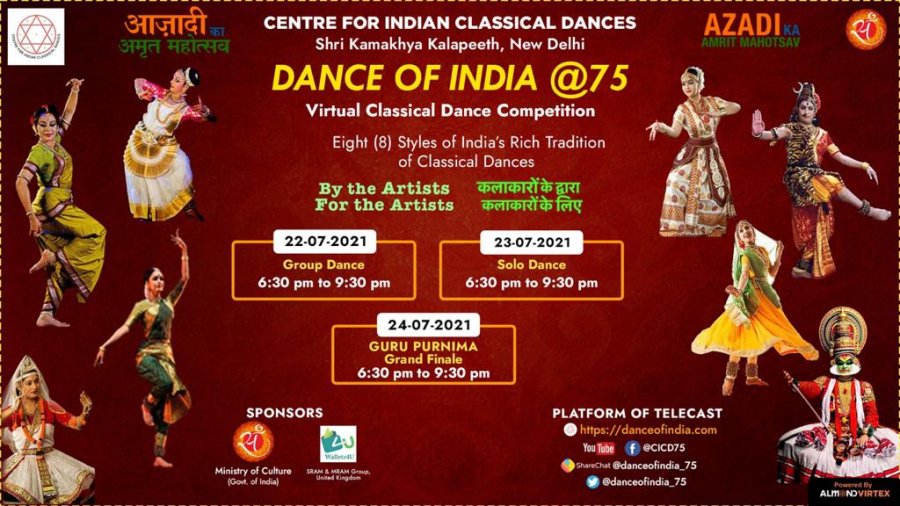 Sonal Mansingh did. Diva, MP too, with indefatigable energy which is visible and infectious. She gets possessed once she gets going. She also has at her command support systems, students and sahradyis. But she has worked very hard for it all. To sustain, maintain and run it. A life like no other. Her own institution the CICD, (the bhumi-pujan ceremony of which I attended some 25 years ago, where the grand building now stands under the benign gaze of ma Kaamakhya) and those associated with it, patrons and parents; minions and ministers, who helped build it and bring it so far, was the main sponsor. Her mega offering in this drab, rainy season - the Dance of India or abbreviated form, DOI@75, energised the gloomy mood. 75 years are symbolic: hers on earth and India as 75 of India too. Bharat is ancient. India is just 75. Wow, the idea of Dance India@75 is well-matched: When universe conspires, all falls in place. She roped in all levels and sections; ancient India, younger India, the very young India and the old, experienced India. So from Gujarat to Guwahati, Amritsar to Asansol, Tillonia to Trichy, there were entries. I was happy to see small-town India, those not readily on dance map like Rajkot or Jalandhar participate too. Judges were kept a secret till the end and while not all had a long PAN INDIAN presence or innings (but were local or regional), most were genuine articles. Now, today, Google being the new guru, if you don't exist on the internet, even in a photo form, then you don't really matter! Or, so it'd seem. Sonal Mansingh included musicians, promoters, impresarios, theatre people, even out of work university people (who haven't danced much professionally but can pontificate professionally!). It was wise not to have too many dance teachers or gurus as judges, in case their own wards were entrants. It is almost unavoidable but at the same time, it'd be unethical too and a serious clash of interest. There was only one national dance critic-historian-author. Sorry for self projection here. Problem is, in a country of a billion, there are only one or two qualified dance historians/critics of international outreach and credibility, or university academicians who know all the forms - not just 8 classical - but folk and films too. Add contemporary and modern. Sonal Mansingh's middle name ought to be Devi Durga /Kaamakhya for she chose judges effectively and sensibly. Mostly. Prize money was high, entry fee was nominal. The idea was made possible largely because it was virtual, else organizing such a feat on this scale physically is impossible. Just as it was near impossible to shift 2 lakh books under team of Dr Gaur, a world level talent; thousands of rare artefacts; 40 collections of which 5 are major (Raja Deen Dayal Photography; Anand Coomaraswamy on Indology; Mohan Khokar Dance Collection; Elizabeth Brunner paintings and Lance Dane coins and crafts) in pandemic times, so was mounting this virtual feast. Hats off to IGNCA team under Member Secretary Dr. Joshi, who delegated the task to Dr. Achal Pandya, head of conservation, for shifting entire IGNCA in a record time: to pack each object in individualized boxes, cartons and all with help of his small team and load/unload many trucks to make many trips up/down Mansingh Road to Janpath. Admin staff under ex-army talent Rangarekar, senior admin Bharat Bhushan Sharma and Jawahar Kumar made it seamless. Dr. Achal Pandya ought to be made DG of Logistics of shifting all museums in Central Vista area, much in news. He delivers well. Such people remain in background and never get mentioned, leave alone celebrated. One noteworthy idea is to name the new hall of IGNCA@JanpatHotel as Rasika Sabha. And present all the 3 main winners there in both categories, when ache din comes and times are near normal. For this virtual competition, folklorist and theatre talent Malavika Joshi steered a team that worked tirelessly behind the scenes, before and during and after the event. Pawan, Sumit, Harsha and many of the IGNCA staff helped behind the scenes, whom Sonal Mansingh motivated and again it shows that where there's a will, there's always a way. See results and all entries on YouTube: danceofindia.com 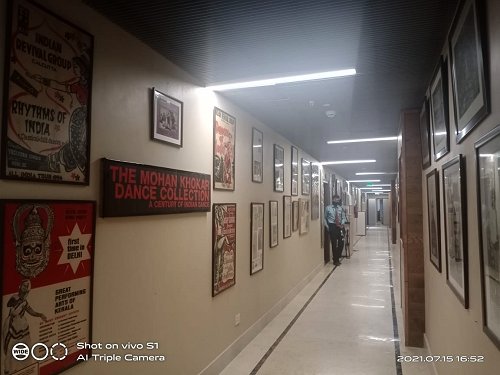 Documenting dance meaningfully, how many institutions are doing it? Do most even have qualified staff? DD did for some years, but that was routine. CPC did some serious work in the 1990s but by then most senior gurus were gone. SNA did, meaningfully by recording its awardees, that's the best record. Now IGNCA is doing academic work, like taking charge of India's largest dance collection and archives - the Mohan Khokar's - and undertaking seminal works like recording 12 hours footage film on Karanas Ujjivanam: Revisited and reconstructed for dance by the one and only Dr. Padma Subrahmanyam. Saraswati ought to be her middle name. Her lifetime work was documented and released on guru purnima recently by the Kala Kosa division of the IGNCA, on its annual day, which shifted from its old building on Mansingh Road to interim one on Janpath (hotel) and an impressive inaugural function marked the occasion on first of July, where many cultural folks of Delhi assembled like happy, colourful butterflies! After a long year of living life indoors due to Karo-Na fear and realities, many were happy to be out, with all Covid protocols in place. Bharatamuni was nicely installed in moolasthana in IGNCA. A sign of good leadership is that a true leader doesn't have to run helter-skelter on show day but sits quietly like the IGNCA head Dr. Sachchidanand Joshi did and enjoyed the seamless function where speeches galored. A spiffy cultural show was put up by Prathibha Prahlad, where our main dance forms were well presented. All dancers managed adroitly on a compact stage, with Tanya Saxena and Suhail Bhan shining. Sadhna Shrivastava conducted with customary finesse and élan. After a long time, it was a joyous function and gathering one attended, the tone having been set by a sonorous Ganapati stuti rendered soulfully by Sudha Raghuraman. Hearing her pure voice and husband Raghu's flute, I felt deep, joyful ananda for and at our arts. 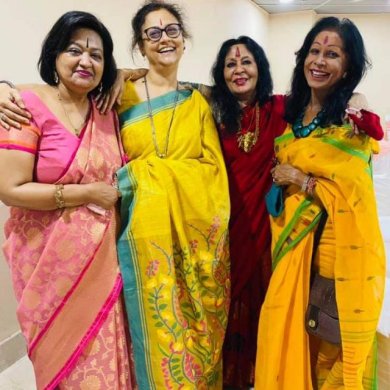 Compere Sadhana Shrivastava, Folklorist Malavika Joshi, Sonal Mansingh with Shovana Narayan 
Down south, lots of dancers keep academically busy not just dance in virtual space for eyeballs. Ananda Shankar Jayant of Hyderabad did a series for and by children, beautifully presented and curated. In Bangalore, the Reva University undertook important subjects as discussions on teaching dance in this pandemic and reaching out etc. While all spoke of teaching online, dancing online didn't get much time. Then too who whets quality? Anything goes and can be put on internet now. The internet is full of that this past pandemic year. Cameos, not art; mime, not dance. Most seem to not have learnt any one art form fully but can do items for ten minutes to any song. My main concern is, watching dance off stage, online: do most have proper training and stamina to dance one hour solo on stage? Or, most are pretty Polly for ten minutes cameo? Or group work, where the weak get covered and the "guru" can dance one solo item and get going. Dancing for camera is far easier than on stage where one can't redo, cut and paste. Let not technology fool many to mistake the banana skin for the fruit. Today, a whole show doesn't last an hour plus. Earlier, just a varnam was at least an hour long. Neither the dancer has stamina nor often, the material to do. Varnam is 15 minutes now; OMG - in today's lingo. So, in this hugely competitive age, where there are 5000 dancers, who will really win in the real competition of life? Just those who are well-grounded and honed. Not light weights. Definitely not "item girls or boys." No organizer wants - especially internationally - a show, where the artiste faints in fifteen minutes. 15 minute of fame is okay, not fainting. No one will put money in that. The show must be proper and go on. In India we can rub each other's back in praise and keep the fake stuff going but the real dollar market or euro, where main earnings still come from, will not support this act of self aggrandizement. Only a few will be valued and they will dominate the dance scene. What it shows is that the flame of art is kept alive by a few. It always has been. Through each generation, there were a handful of gurus who left their villages and came to cities to teach. In each form. Pre-independence this was the story of principal forms like Bharatanatyam and Kathak. Two most learnt forms then and now, pan Indian. Rest, by and large remained regional. Except Odissi that reached out globally some 30 years ago. Now, Sattriya is slowly getting support in reaching out. A century ago, BN and Kathak gurus left their Pandanallur and Kattumannarkoil to come to a big city like Madras to teach the first generation in 1930s. Their students followed next from Vazhuvoor or Chidambaram. The first generation gurus were mostly male nattuvunars; they did not dance themselves. They just taught. Often free! Ditto in Kathak from Churu or Awadh. They established gharanas and banis, which were loosely there but before them and their overzealous students, no one needed branding or territorial one-upmanship. These historical trends interest me immensely but even current crop of teachers don't know their histories much. Or care to. This will ultimately undo their own work in the long run as there will be a free for all, no litmus test or quality control. How can one tell the good, from the very good, bad or ugly? While being judgemental is not the need of the hour, being a goldsmith who assesses 18/22/24 carat is. Else, how does one put a value even on it? Today's story is yesterday's history. The story or HIStory of our forms has been much written about but on internet now, people are just copying many of my last 40 years of writing and just here and there quoting me, thus absolving themselves of legal or copyright issues! I see daily some recycled stuff, whole 2000 words copied from my works being used nicely. 3 even converted them to PhD and I was asked to cross check for facts! Plagiarism at its worst. Wow, indeed. Peer papers from abroad, submitted with a million protocols, are so much technical work that it costs lots of time, for doing free work! The most irritating new trend is RESEARCH QUESTIONNAIRES. Shoot off 5 to ten questions to 100 people in the field and cut and paste the replies. The candidate saves on their homework while we have to sit and reply. I don't encourage this easily. Do the proper way. Read, revert to a specific point and ask to be guided. Not ready made answers collated and compiled in a jiffy. While distance makes internet a tool to reach out, it cannot be its panacea. Do some real spade work, dear students! 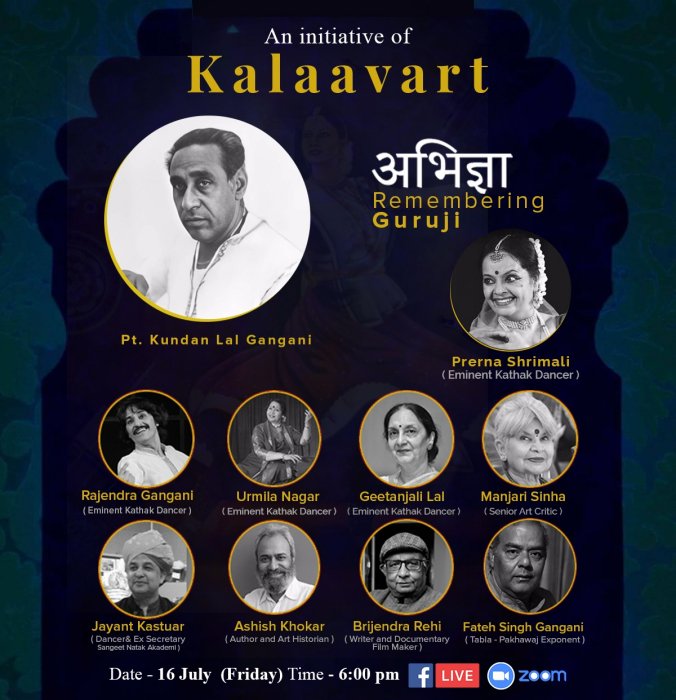 Work is worship. When I see the selflessness of some who teach in their own limited set ups, the Sampada Pillais and Tushar Bhatts or seniors like Prerna Shrimalis and Madhus of the world, I am touched they continue with mission impossible. Prerna conducted the most meaningful tribute function in memory of an unsung hero of Kathak, Guru Kundanlal Gangani, fountain head of Jaipur gharana. She got many of his old acolytes to learn from and new generation benefitted. Madhu, the dance-designer, undertook courses through her STEM-turned-plant that's becoming a tree. Each one is adding to pool that is dance. So many more; Masoom Parmar offering a course in arts admin; Attakkalari getting a Korean link (hope it's South, not North!) to support arts. In Kolkata, senior arts curator Ratnottama Sengupta is compiling a film on dance in films. It is one of my favourite subjects too, last 15 years through our Dance Discourse materials. Alas, dance is not such a paying field. A painting done in privacy and comfort of home and unstructured time often fetches more. Dance needs support from powers that be, since it is the most fragile art form. Music survives through recordings. Art works through preservation. Dance is for the moment. What can one do even with a film on the subject? Show it for free! Where's the return or revenue? Without thinking of returns or revenue, Sunayana Hazarilal, the senior Kathak guru, has mounted her portal natawari.org with help of research author Malay of USA. Lots of interesting information is there on Janaki Prasad gharana. A must see. Please don't expect government to do any more, even spoon feeding. It has done what it could. When under 3% Indians pay taxes, yes just 2.38! Then to think a government, any govt. can feed all for free, maintain and molly coddle them, is simply not possible. It's time for society to do so. Start-up food joints and chutney dish sell for more. Why not art? When so much sells on the net now, even vegetables - home delivered in the pandemic - why not art? It is because our society has put so little value on it. They put on kachra TV entertainment, even dance shows with no Indian dance forms, still no one says anything. It is left for a few of us to hold the light, aflame. So be it! 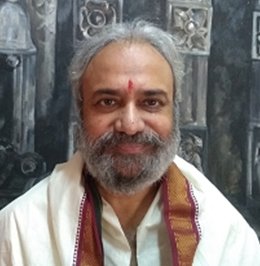 Khokar is a senior, seasoned dance commentator with 40 years solid work in art field as a pioneer arts administrator, archivist, critic, curator, author, academician and more. Detailed bio on attendance-india.com Responses * Dear Ashish, Just finished reading your article. So depressingly truthful. It is precious to have someone like you being able to figure out today's scene and also bring us back to what it used to be. It is like doing a « grand écart » between times. I feel I have been so lucky to be witness and part of « what it used to be ». Reading your words makes me feel nostalgic. - Annette Leday (July 30, 2021) * Well understood senerio today, also written in a nice manner so as to combine the whole art situation today, at the same time kudos to so many persons who continued so much work during these pandemic times. Online programs were outnumbered to the maximum extent; just a feeling of existence with dance & music created a strength within us. Of course teaching online was fun in the beginning, then it became a need of the hour, hoping things go well for all. Ashish ji always makes the read actual for us. Of course, Narthaki has been doing a great service for so long. - Prashanth Gopal Shastry (July 28, 2021) * This is the harsh reality of Karo-Na Kaal. People are doing n number of things to promote themselves but the way you mentioned about stamina of the dancers is very true. Some are tech-illiterate, which is another challenge to face. I have seen many online concerts - rarely people have patience to see the performance starting from 1st second to last minute, else many of them just exit the room for their work. By which I personally do not favour this online presentation of such beautiful arts we have been learning for decades and decades. Shortcut is the prime key of today’s world. Cut, copy, paste and become famous is the only agenda. Realness of the work has completely vanished. I am too young to add anything here but by reading this, I actually realized the surroundings I am living with. Keep sharing such articulation of your observations in the real world. We all need it badly. - Sukanya Nayancy Sahu (July 28, 2021) * Congratulations, Ashish ji, on housing the priceless collection spanning our rich cultural tradition and heritage since over a century. Your sustained and meticulous efforts with so much endurance, toil, despite challenges finally is available to artists and general public, for research, learning or even appreciation. It’s easier to go to Mars nowadays. It’s a real Olympic feat you have accomplished. - Murali Mohan Kalvakalva (July 28, 2021) Post your comments Please provide your name and email id when you use the Anonymous/blog profile to post a comment. All appropriate comments posted with name and email id in the blog will also be featured in the site. |